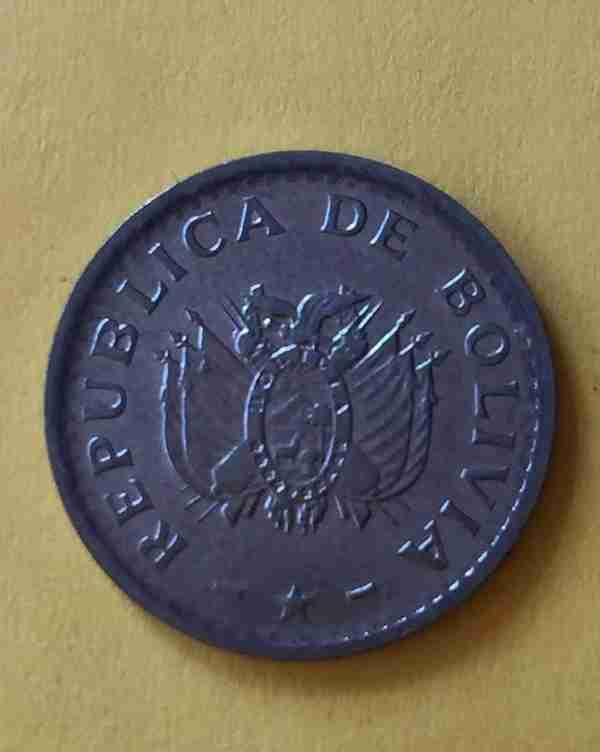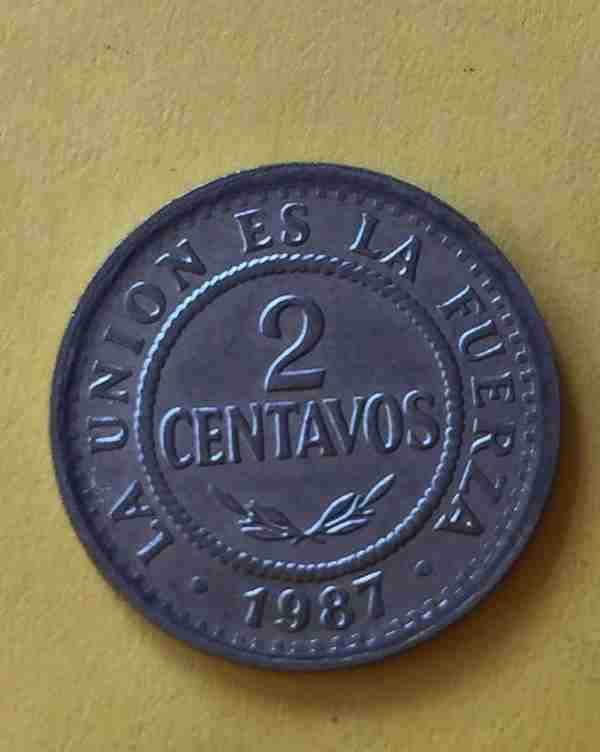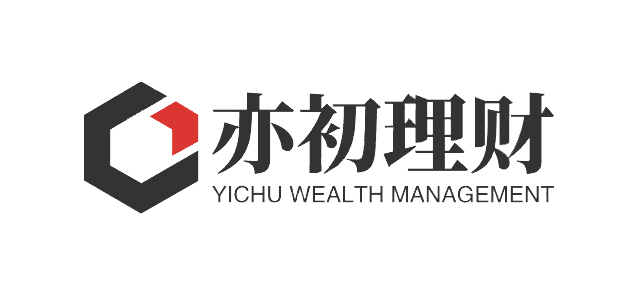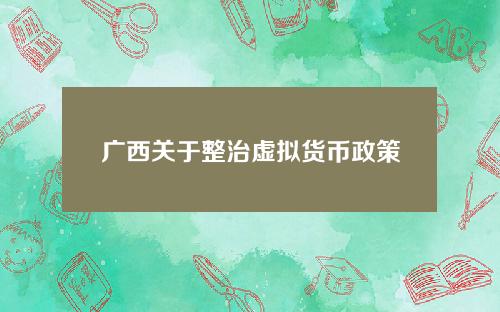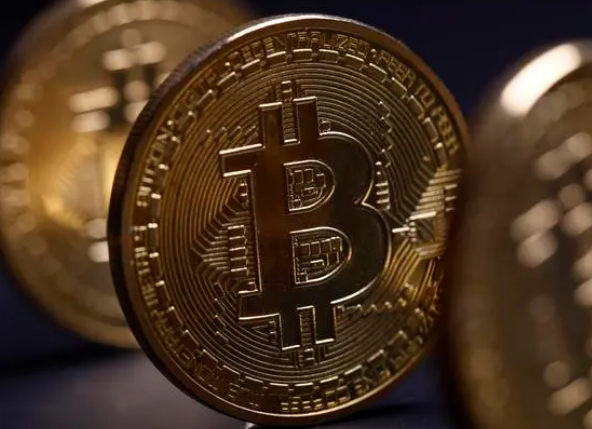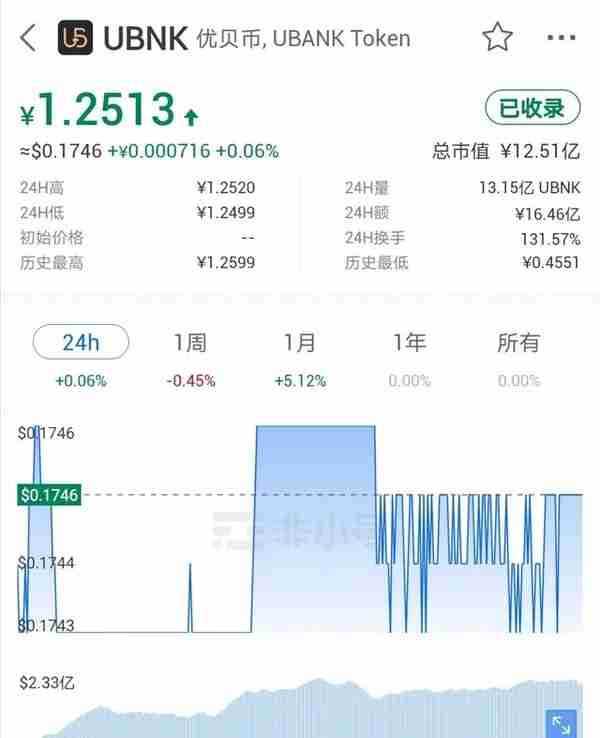玻利维亚1987年版2分硬币(收于2021年)玻利维亚全称多民族玻利维亚国,是位于南美洲中部的内陆国家。国土面积:1098000平方公里;人口数量:1121.6万(2018年);首都:苏克雷(实际政府驻地为拉巴斯)。总统:路易斯·阿尔韦托·阿尔塞·卡塔科拉。
玻利维亚在13世纪为印加帝国的一部分。1538年沦为西班牙殖民地,史上称秘鲁,隶属于西班牙拉普拉塔总督区。1825年8月6日宣布独立,取名玻利瓦尔共和国,后改为玻利维亚共和国。1836年同秘鲁组成联邦,1839年由于智利入侵而瓦解。南美"太平洋战争"又称"硝石战争"后,玻利维亚丧失其唯一滨海省份,失去了出海口而成为内陆国。2009年3月26日将原国名改为"多民族玻利维亚国"。
玻利维亚奉行独立自主、和平和不结盟的对外政策,维护民族独立和主权,突出多元外交和务实经济外交。系不结盟运动、世界贸易组织、美洲国家组织、拉美和加勒比国家共同体、南美国家联盟、安第斯共同体、里约集团、拉普拉塔河流域组织、亚马孙合作条约组织等成员国和南方共同市场联系国。同86个国家保持外交关系。1985年7月9日,中华人民共和国和多民族玻利维亚国建立外交关系。
玻利维亚工业不发达,畜牧产品可满足国内大部分需求,粮食需大量进口。是拉美主要矿产品出口国,有"坐在金矿上的驴"之称;拥有号称世界第三大的平托冶炼厂。拥有南美洲第二大天然气田。古柯种植在玻利维亚国民经济中占有较重要的地位。认为该国特产的古柯不是毒品,呼吁国际社会为古柯"解禁"。藜麦已经开始成为新兴的农作物得到国际资金的扶持。中国成为玻全球第二大贸易伙伴,第一大进口来源国和第七大出口目的地国。2013年12月21日零时42分,中国在西昌卫星发射中心用长征三号乙运载火箭,成功将玻利维亚拥有的第一颗卫星(玻利维亚通信卫星)发射升空,顺利进入预定轨道。玻政府将教育文化、健康营养、卫生设施、城市建设和住房、就业等列为社会发展政策中需要迫切解决的问题。对6-12岁儿童实行义务教育。
玻利维亚诺是玻利维亚的流通货币。辅币单位为分,1玻利维亚诺=100分。此2分硬币正面主图为国名和国徽图样;国徽中间为椭圆形,圆面上有太阳、山峰、面包树、驼羊、谷物等图案。圆周上半部用西班牙文写着"玻利维亚"。下半部十颗五角星代表组成玻利维亚的9个省和被智利夺去的沿海省;椭圆形上端的大兀鹰,象征力量和自由。鹰两旁饰有月桂枝和橄榄枝,代表人民对民族自由的自豪感和与其他国家人民和睦相处的愿望。椭圆形两侧各悬挂三面国旗;背后交叉着象征权威的束棒和武器;左边的束棒顶端有一顶"自由之帽"。背面主图为发行年份、面额及玻利维亚的国家格言“团结就是力量”。 Bolivia, the Plurinational State of Bolivia, is a landlocked country in the middle of South America. Land area:1,098,000 square kilometers; Population:11.216million(2018);Capital:Sucre (actual government residence is La Paz).President:Luis Alberto Arce Catacora.
Bolivia was part of the Inca Empire in the 13th century. In 1538, it became a Spanish colony, which was called Peru in history and belonged to the Governor's District of La Plata, Spain. Independence was declared on August 6, 1825, and it was named Bolivarian Republic, later changed to Bolivia Republic. It formed a union with Peru in 1836 and collapsed in 1839 due to Chile's invasion. After the "Pacific War" in South America, also known as the "saltpeter War", Bolivia lost its only coastal province, lost its seaport and became a landlocked country. On March 26, 2009, the original name was changed to "Bolivia (Plurinational State of)".
Bolivia pursues an independent, peaceful and non-aligned foreign policy, safeguards national independence and sovereignty, and highlights pluralistic diplomacy and pragmatic economic diplomacy. It is a member of the Non-Aligned Movement, the World Trade Organization, the Organization of American States, the Community of Latin American and Caribbean States, the Union of South American Nations, the Andean Community, the Rio Group, the La Plata River Basin Organization, the Amazon Cooperation Treaty Organization and other associated countries of MERCOSUR. Maintain diplomatic relations with 86 countries. On July 9, 1985, the People's Republic of China and the Plurinational State of Bolivia established diplomatic relations.
Bolivia's industry is underdeveloped, livestock products can meet most domestic demand, and food needs to be imported in large quantities. It is a major exporter of mineral products in Latin America and is known as the "donkey sitting on a gold mine"; It owns the Vinto Smelter, which is known as the third largest in the world. It has the second largest natural gas field in South America. Coca cultivation in Bolivia occupies an important position in the national economy, and considers that the coca is not a drug, and calls on the international community to "lift the ban" on coca. Quinoa has begun to become a new crop, supported by international funds. China has become Bolivia's second largest trading partner, the largest import source country and the seventh largest export destination country. At 00: 42 on December 21, 2013, China successfully launched the first satellite owned by Bolivia (Bolivian Communication Satellite) by long march 3b in xichang satellite launch center, and successfully entered the scheduled orbit. The Bolivian government has listed education and culture, health and nutrition, sanitation facilities, urban construction, housing and employment as urgent problems to be solved in the social development policy. Compulsory education for children aged 6-12.
Boliviano is Bolivia's currency. The unit of secondary currency is Centavo,1Boliviano =100 Centavos. The front main picture of this 2-Centavo coin is the country name and national emblem pattern;The national emblem is oval in the middle, with the sun, mountain peaks, bread trees, camel sheep, grains and other patterns on the round surface. In the upper part of the circumference, "Bolivia" is written in Spanish. The ten five-pointed stars in the lower half represent the nine provinces that make up Bolivia and the coastal provinces that were taken away by Chile; The big vulture at the top of the ellipse symbolizes strength and freedom. The eagle is decorated with cassia twigs and olive branches on both sides, representing people's pride in national freedom and their desire to live in harmony with people of other countries. Three national flags are hung on each side of the ellipse; Behind it is crossed with a bundle of sticks and weapons symbolizing authority; There is a "freedom hat" at the top of the bundle bar on the left.The main picture on the back shows the release year, denomination and Bolivia's national motto "la union es la fuerza".
